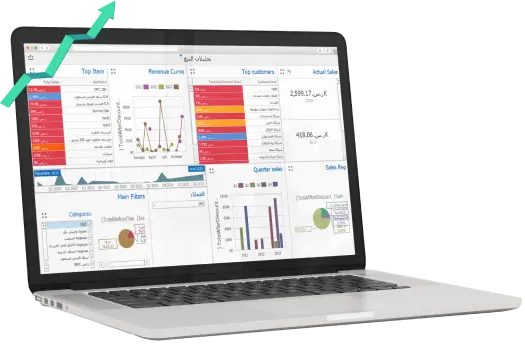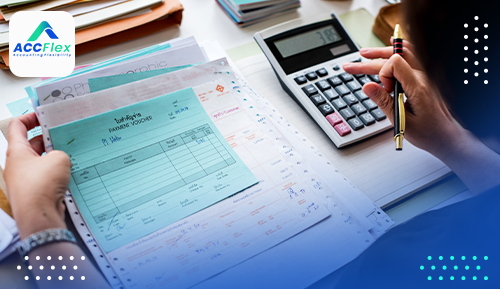Operating leverage is part of the business risk that the company may face; the idea of operating leverage is that the cost structure in any company consists of fixed costs and variable costs
Fixed costs: are costs that do not change in response to changes in the volume of production. As for the variable costs, they are the costs that increase or decrease depending on a company's production volume. Fixed costs are variable per unit because as the production increases, the one unit of fixed costs decreases because they are distributed to the largest number of production units, unlike the variable cost is fixed per unit and the total variable costs increase with the increase in the volume of production, and therefore the fixed costs increase in the cost structure of the company the is highly sensitive to changes in sales, upward and downward because higher sales mean an increase in profits, and a decrease in sales means a lower profit
Thus, the operating leverage (fixed costs are greater in the firm's cost structure)
Increasing the risk of the company because the change in sales would have an impact on the change in profits
Degree of operating leverage = contribution margin / operating income
The higher the degree of operating leverage, meaning that the company must increase sales in order to cover the operating leverage, and the greater the sales volume, the lower the degree of operating leverage, and the more the company reaches the break-even point, the more the degree of operating leverage begins to decrease
High operating leverage will be in companies such as cement, aviation, steel, and petroleum, and operating leverage is one and not all of the components of business risk and the degree of operating leverage can be used in forecasting profits
Business Risk
One of the important matters that a financial analyst should analyze on fiscal periods is the degree of business risk
Means the sensitive net operating income to change due to change in sales, which is equal to
= Change in operating income / Change in sales
And the operating profit equals gross profit - fixed costs (administrative expenses, marketing expenses)
Operating profit is dramatically affected by the presence of fixed costs in the firm's cost structure (operating leverage)
This means that the degree of operating leverage determines to a large extent the value of business risks in the company. If the value of the fixed costs of the company increases, this means that the degree of operating leverage will increase, and thus the degree of business risks to which the company is exposed increases
Also, business risks are directly associated with sales and its sensitivity to an increase or decrease in the company, and with the increase in its fixed costs, it must increase the value of its sales in order to offset the fixed costs and to avoid the risks that it may be exposed to, such as decrease and profit fluctuations dramatically
For example, if we assume that the value of the degree of business risk = 5
This matter means that a change in sales of 10% leads to a change in operating income of 50%, meaning whether there is an increase or decrease and the relationship is positive, which means a high degree of business risk that the company is exposed to
The high degree of operating leverage and the increase of the break-even point lead to an increase in the degree of business risk to which the company is exposed, and thus a lower margin of safety
Thus, we could say that
Degree of operating leverage = contribution margin / operating income
Degree of business risk = Change in operating income / Change in sales
The degree of business risk and operating leverage can be used in forecasting operating profit
The degree of operating leverage is useful for the company if the firm can use fixed costs to increase sales
Firms that do not with huge fixed costs in their cost structure, any change in the sales ratio leads to a change in operating income in the same percentage
Conversely, the company with huge fixed costs in its cost structure
If sales are greater than the break-even point, the operating leverage will be positive
If sales are below the break-even point, operating leverage will be negative
The use of operating leverage is useful for the company in times of economic boom because any increase in sales leads to an increase in profit by a greater percentage and in times of depression, and an increase in the operating leverage ratio is a negative thing for the company because any decrease in sales leads to a decrease in operating income
The basic idea of operating leverage analysis and break-even point
The basic idea is to classify costs into
Fixed Operating Costs, Variable Operating Costs, and Mixed Costs
Fixed Operating Costs
Such as depreciation, insurance, rent of a building, real estate taxes, salaries, administrative costs, marketing campaigns, and maintenance expenses in the sense that they do not differ according to the levels of the volume of production in the sense that is an expense that does not change as production volume increases or decreases within a relevant range, these costs are incurred regardless of the company's production volume, meaning whether it is full production capacity producing or part of it, it incurs fixed costs
Variable Operating Costs
Are a corporate expense that changes in proportion to production output, such as direct raw materials, electricity, packaging materials, maintenance costs, and sales commission. The financial management its concern is to reach the break-even point as a first and basic step in the company growth, once the company’s revenues cover its total costs, the next step will be to increase production and sales and meaning that any increase in the break-even point will make the company more profitable
There are mixed costs between fixed and variable and separated by some methods
The importance of Operating Leverage
The degree of operating leverage is one of the most important ratios are because companies with a high degree of operating leverage and therefore a high-risk business, their financial decisions are affected because the management at this time tends to increase reliance on self-financing and reduce loan financing, and this is not by choosing it, but that is a reality as a result of banks and lending institutions tend to borrow large amounts for the firms a low degree of business risk compared to a high degree of business risk
Because they believe that companies with a low business risk will be a low degree of risk and therefore can pay interest on the loan + loan principal amount on the maturity dates without the company being bankruptcy, and therefore the companies aim to a low degree of business risk by using the operating leverage (fixed costs significantly) in increasing sales dramatically leads to an increase in operating profit and increasing the return on investment and maximizing the market value of a share
At the beginning of the business activity, it is often buying the production lines, the construction of buildings, and paying salaries and wages, and often there is no revenue because there are not sufficient sales and therefore higher operating leverage and sales are low in a way that does not cover fixed costs and therefore companies in these cases have a high degree of business risk, and therefore to reduce fixed costs by reducing manufacturing overhead costs if possible to lead to dramatically reduce the break-even point and a low operating leverage and thus a low business risk, which leads to profit improvement provided the stability of the sales or increasing them
Changing prices usually affect the sales volume of the company, but the price change is associated with many factors such as production or procurement cost and also the competitors' prices in the market and the raising the price may dramatically affect the company's sales volume, and the price can be reduced affects an increase the amount of the company's sales and therefore the compensate for the difference in prices
Financial Leverage
Financial leverage is the degree to which the company depends on debt in its financing structure, meaning how much the debt ratio is for the shareholder equity ratio and the financial leverage increases the financing risk facing the company and that is due to the financial leverage of the burden of debt service in the form of paying installments of this debt and interest, debt financing has advantages, which are that loan interest is deducted from the tax base, while cash dividends resulting from equity financing are not deducted from the tax base, but when the company fails to pay installments and interest, it leads to financial problems, unlike shareholders' equity, it does not represent any liability to the company, where the company has no legal liability to pay dividends to the shareholders
Financial leverage is good when the return on assets ratio is greater than the used loan interest rate and will lead to an increase in the return on shareholders' equity ratio, and vice versa in the case of decline, and the more than financial leverage ratio this means that the company is exposed to high financial risk and any investor when purchasing shares in the company taking into consideration the degree of company's financial risk, which could be exposed and the company's ability to pay interest payments and outstanding loans and therefore the funding decision and its structure determines the degree of financial risks that the company may be exposed to, meaning that the more reliance on debt as a source of financing, this means the increase in fixed costs, which are interest
The use of financial leverage or debt financing is useful and important for the company if the economic situation in the country is good, meaning that the return on assets exceeds the cost of loans in the sense that the return on assets ratio is 10% and the interest rate is 8%, in this case, the use of financial leverage or debt financing is useful and feasible for the company, and vice versa, of course, if the economic situation in the country is not good, and consequently the interest rate on loans will be high and the return on assets ratio may decline, so the use of financial leverage will be useless and the best then is that the self-financing through shareholders' equity by issuing shares so that it has the ability to pay the debt and the interest regularly
Degree of Financial Leverage
Financial leverage is the total debt to shareholders' equity or total debt to total assets of the company
(Total Debt / Total Assets)× 100%
This means the company assets are funded how much of debt and liabilities
Assuming that, for example, that the financial leverage ratio is 60%, meaning that the financing structure of this company is 60%, loans and external financing and 40% self-financing
In other words, 60% of the assets are financed by debt and the rest 40% are self-financing from shareholders' equity
If the company is not able to pay the liabilities, whether accrued loans or interest, it will fall into problems, the least of which is financial hardship, then bankruptcy and liquidation
These two ratios are complementary to each other, and when the degree of financial leverage increases, the degree of financial risks increases that the company may be exposed to
Degree of Financial Risk
It is the sensitivity of net profit after tax, the change of increase or decrease according to the change in operating profit, increase or decrease
It can be calculated in one of two methods
The first method = (operating income) / operating income - Interest
Meaning if the company operating profit = 1,000,000 pounds and interest 200,000 pounds, meaning that the degree of financial leverage or the degree of financial risk =
1000000/ 800000 = 1.25
Meaning that an increase in operating profit of 1% will lead to an increase in the net distributable profit (net profit after tax - preferred stock dividends, if any) of 1.25% and vice versa in the case of a similar decrease
The second method, which is used to measure the degree of financial risk from two income statements, which is more accurate
= Change in distributable profit / Change in operating income
Meaning that in 2012 the distributable profit was 500 and in 2011 the distributable profit was 300
In 2012, operating profit was 700; in 2011, operating profit was 500
Change in distributable profit = (500-300) / 300 = 66.6%
Change in operating income = (700-500) / 500 = 40%
Degree of Financial Risk= 66.6 / 40 = 1.6%
Meaning that an increase in operating profit of 1%, for example, leads to an increase in distributable profit of 1.6%, and vice versa in the case of a decrease
Let say a company with a financial leverage of 40%, then this means that it is in a better position compared to a company with a financial leverage of 60% and therefore is exposed to less financial risks than with a financial leverage of 60%
Forecasting profit using the degree of financial risk
The degree of financial risk can be used to forecast the change in distributable profits (profit after tax) as a result of the change in operating income
And the formula is as follows:
Change in profit after tax (distributable profit) = degree of financial risk × Change in operating income
Meaning that, for example, if the degree of financial risk was 1.25 in the previous period, and an increase in operating profit of 40% compared to the previous period, in order to calculate the extent of the change in the distributable profits after tax, it is as follows:
= 1.25 × 40% = 50%
It means if operating profit increase of 40% at a degree of financial risk of 1.25, then profit after tax will increase of 50%
To illustrate with an example
Net operating income = 210,000
Net Operating Profit After Tax = 180,000
Expected net operating income = 350,000
Expected Net Operating Profit After Taxes = 325,000
Degree of Financial Risk
Change in profit after tax
= (325,000-180000) / 180,000 = 80%
Change in operating income
= (350000 - 210000) / 210000 = 67%
Degree of Financial Risk or Degree of Financial Leverage
= 80% / 67% = 1.19 times
This means that if the net operating profit increases of 100%, meaning that profit after tax increases of 119%
If operating profit increase of 15%, the profit after tax increasing of 1.19 × 15% = 17.85%, and also in the case of a decrease in operating profit









